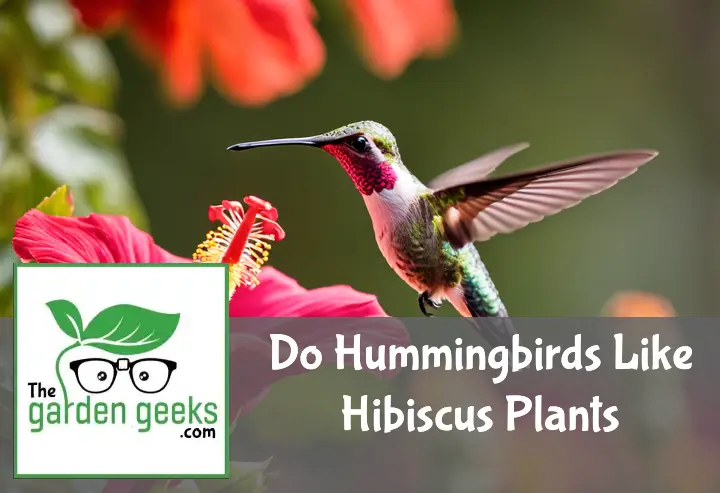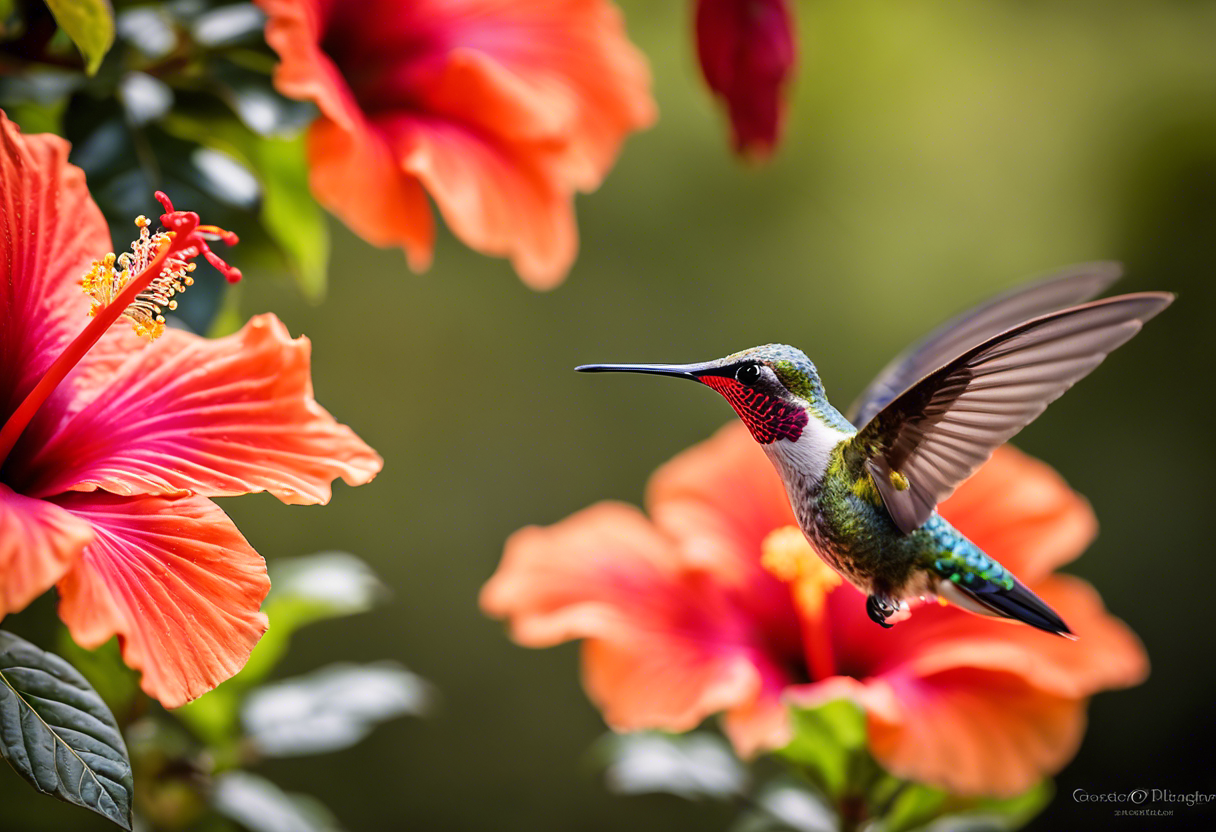Ever found yourself sipping on your morning coffee, gazing out the window, and wondering Do Hummingbirds Like Hibiscus Plants? Well, you’re not alone. It’s a question that has puzzled many a bird-lover and gardener alike.
Let me share a little story. Last summer, I got myself a gorgeous hibiscus plant for my patio. And boy oh boy, it turned into a regular hummingbird hotspot! So yes, in my experience, those tiny fluttering wonders sure do love hibiscus. But why is that so? Keep reading about ‘Do Hummingbirds Like Hibiscus Plants?’ to find out!
Key Takeaways
- Yes, hummingbirds are attracted to hibiscus plants.
- Hibiscus flowers provide a rich source of nectar, which is a primary food source for hummingbirds.
- The bright colors of hibiscus, especially red, are highly appealing to hummingbirds.
- Planting hibiscus can help attract more hummingbirds to your garden.
- However, it’s important to ensure the plant’s health as unhealthy plants may not produce enough nectar.
What are Hummingbirds?
Hummingbirds, those tiny, vibrant aviators that captivate our hearts. With over 300 different hummingbird species, they’re a diverse bunch, each with unique quirks and behaviors. They are fascinating creatures, and there’s more to them than meets the eye. We’ll delve into some cool hummingbird facts and explore the different types of hummingbirds and their diets.
Characteristics of Hummingbirds
When it comes to size, hummingbirds are small but mighty. Most species measure between 7.5–13 cm in length. Their wingspan is equally impressive, beating up to 80 times per second during normal flight! Now that’s what I call a workout!
Their dazzling hummingbird colors range from emerald greens to ruby reds, making them a sight for sore eyes in any garden. But it’s not just about looks; their feeding habits are also quite intriguing.
Hummingbirds have a sweet tooth – or should I say beak? They feed on nectar from flowers using their long, slender beaks. This high-energy diet fuels their rapid hummingbird flight speed, which can reach up to 60 miles per hour!
Habitats and Migration Patterns of Hummingbirds
Now let’s talk about where these little fellas hang out – their habitats! The hummingbird habitat range is vast, covering North and South America. From the chilly Alaskan coasts to the tropical rainforests of Brazil, these birds know how to pick a scenic home!
But they don’t stay put all year round. Oh no! These globe-trotters follow specific migration routes, moving between breeding and non-breeding areas seasonally.
The seasonal movement of hummingbirds is influenced by food availability and weather conditions. When winter hits in the north, they head south in search of warmer climates and blooming flowers.
But here’s a fun fact: Not all hummingbirds migrate. Some species, particularly those in the tropics, are year-round residents. So, whether it’s the preferred habitats for hummingbirds or the factors influencing hummingbird migration, these birds sure know how to live life on the wing!
What are Hibiscus Plants?
Well, let’s dive right into the world of hibiscus plants. These beauties originate from warm, tropical regions and are known for their large, showy flowers. They’ve got a range of types and growing conditions that we’ll explore in a bit.
Description and Types of Hibiscus
Hibiscus plants are quite the lookers with their bold colors and large petals. Now, there are many types of hibiscus out there, but the most common ones you’d find in gardens are the Hibiscus syriacus (Rose of Sharon) and Hibiscus rosa-sinensis (Tropical Hibiscus).
The Rose of Sharon is a hardy fella with smaller flowers while our Tropical Hibiscus flaunts larger blooms and loves warmer climates. Each type has its own unique charm, making them a delightful addition to any garden.
Growing Conditions for Hibiscus Plants
Now onto the nitty-gritty – how do we grow these lovelies? Well, hibiscuses love sunlight so make sure they get plenty of it. They’re sun worshippers at heart!
As for temperature, they prefer it warm but can tolerate cooler climates if needed. Watering needs vary depending on the type but generally speaking, keep ’em well-watered without drowning them.
And soil? Well-drained soil with good fertility is what they crave. So there you have it folks – your quick guide to growing happy hibiscus plants!
Do Hummingbirds Like Hibiscus Plants?
Well, let’s dive right into it. Do hummingbirds like hibiscus plants? You bet they do! It’s a love story written in the stars, or rather, in the petals and nectar of these vibrant flowers.
The Attraction of Hummingbirds to Flowers
Hummingbirds are quite the flower enthusiasts. They’re particularly fond of nectar-rich flowers, which form a significant part of their diet. These little avian acrobats have a sweet tooth, you see. They need high-energy food like nectar to fuel their rapid wing-flapping and darting flight patterns.
But it’s not just about the nectar. Hummingbirds also play an important role in pollination. As they zip from flower to flower sipping on sweet nectar, they inadvertently transfer pollen grains stuck on their beaks or feathers. It’s nature’s version of a two-for-one deal!
And let’s not forget about color preference. These birds have a thing for bright colors, especially reds and oranges. Add to that their keen sense of smell which helps them detect scent attraction from afar, and you’ve got yourself a bird that’s head over heels for flowers!
Specific Appeal of Hibiscus to Hummingbirds
Now onto why hummingbirds are particularly smitten with hibiscus plants. First off, hibiscus flowers are rich in nectar – it’s like the premium-grade fuel for these high-energy birds.
Next up is color appeal. Hibiscus plants often flaunt bold red blooms – a color that hummingbirds find irresistible! It’s like waving a red flag at a bull – only much friendlier and less dangerous.
The size of hibiscus flowers is another plus point for our feathered friends. Their large size and open shape provide easy access for hummingbirds to reach the nectar. It’s like a welcome mat inviting them in for a quick snack.
Finally, the unique scent of hibiscus flowers acts as an olfactory beacon for these birds. It’s like nature’s version of GPS, guiding hummingbirds straight to their nectar-filled destination. So there you have it – hibiscus plants are basically hummingbird magnets!
How to Attract Hummingbirds with Hibiscus Plants?
Well, let’s dive right into it. Do Hummingbirds Like Hibiscus Plants? You bet they do! These flitting beauties are absolutely smitten with hibiscus plants. It’s like a love story straight out of a Disney movie, folks!
Choosing the Right Variety of Hibiscus
Now, not all hibiscuses are created equal in the eyes of our feathered friends. Some varieties are like hummingbird magnets! Look for nectar-rich hibiscus and large-bloom hibiscus varieties. The bigger the bloom and the sweeter the nectar, the more your garden will be buzzing with these tiny winged wonders. And let’s not forget about color! Hummingbirds have a thing for bright hues, so go for those vibrant colorful hibiscus flowers.
Planting and Care Tips for Hibiscus
Alrighty then, you’ve picked out your perfect hibiscus variety. Now what? Well, proper planting and care is key to making your garden a hummingbird hotspot. Follow these simple planting hibiscus tips and you’ll be on your way to creating a hummingbird haven in no time! Remember to keep those hibiscuses in bird gardens healthy by providing plenty of sun and water. A well-cared-for plant is an irresistible invitation for these little guys. So get out there and start encouraging hummingbird visits today!
Other Plants that Attract Hummingbirds
When it comes to attracting hummingbirds, hibiscus isn’t the only game in town. There’s a whole world of hummingbird-friendly plants out there, each with their own unique appeal.
List of Other Flowering Plants
Take the trumpet vine for example. Its bright orange flowers are like a neon sign for hummingbirds, saying “Free nectar here!” Then there’s the bee balm, a real crowd-pleaser with its colorful blooms for birds.
And let’s not forget about salvia. This plant is practically a hummingbird magnet with its vibrant red flowers and abundant nectar. If you’re looking to create a bird-attracting flora, these are some top-notch choices.
Comparison Between Hibiscus and Other Plants
But how does hibiscus stack up against these other bird garden plants? Well, when it comes to hibiscus vs other flowers, it’s really apples and oranges…or should we say hibiscus and salvias?
Hibiscus has large, showy flowers that can be quite appealing to hummingbirds. However, they might require more care than some of the other nectar-rich flowers we’ve mentioned.
On the flip side, plants like salvia or bee balm are pretty low-maintenance but still offer plenty of nectar for our feathered friends. So if you’re asking “Do Hummingbirds Like Hibiscus Plants?”, the answer is yes! But they also enjoy a variety of other tasty treats in your garden.
To Wrap Up
In the grand dance of nature, hummingbirds and hibiscus plants are like Fred Astaire and Ginger Rogers – perfectly in sync. To answer your question, Do Hummingbirds Like Hibiscus Plants? Absolutely, they do!
So why not add a splash of tropical flair to your garden with some hibiscus plants? You’ll be hosting a hummingbird hoedown before you know it!



